Combined Triboelectric and Piezoelectric Effect in ZnO/PVDF Hybrid-Based Fiber-Structured Nanogenerator with PDMS:Carbon Black Electrodes
Abstract
:1. Introduction
2. Experimental Section
3. Results and Discussion
3.1. Material Characterization
3.2. Fiber Nanogenerator Electrical Properties
4. Conclusions
Author Contributions
Funding
Institutional Review Board Statement
Informed Consent Statement
Data Availability Statement
Conflicts of Interest
References
- Wang, Z.L.; Song, J. Piezoelectric Nanogenerators Based on Zinc Oxide Nanowire Arrays. Science 2006, 312, 242–246. [Google Scholar] [CrossRef] [PubMed]
- Guo, B.; Zhang, D.; Wang, Z.; Yu, Z.; Zhou, X. Opportunistic IoT: Exploring the Harmonious Interaction between Human and the Internet of Things. J. Netw. Comput. Appl. 2013, 36, 1531–1539. [Google Scholar] [CrossRef]
- Nakad, Z.; Jones, M.; Martin, T. Communications in Electronic Textile Systems. In Proceedings of the 3rd International Conference on Communications in Computing, Las Vegas, NV, USA, 23–26 June 2003; pp. 37–43. [Google Scholar]
- Liu, Z.; Wang, J.; Zhang, Q.; Li, Z.; Li, Z.; Cheng, L.; Dai, F. Electrospinning Silk Fibroin/Graphene Nanofiber Membrane Used for 3D Wearable Pressure Sensor. Polymers 2022, 14, 3875. [Google Scholar] [CrossRef] [PubMed]
- Van Tran, V.; Lee, S.; Lee, D.; Le, T.-H. Recent Developments and Implementations of Conductive Polymer-Based Flexible Devices in Sensing Applications. Polymers 2022, 14, 3730. [Google Scholar] [CrossRef] [PubMed]
- Rajak, D.; Pagar, D.; Menezes, P.; Linul, E. Fiber-Reinforced Polymer Composites: Manufacturing, Properties, and Applications. Polymers 2019, 11, 1667. [Google Scholar] [CrossRef] [PubMed] [Green Version]
- Yan, T.; Chen, D.; Zhao, B.; Jiang, X.; Wang, L.; Li, Y. Percolation Network Formation in Nylon 6/Montmorillonite Nanocomposites: A Critical Structural Insight and the Impact on Solidification Process and Mechanical Behavior. Polymers 2022, 14, 3672. [Google Scholar] [CrossRef] [PubMed]
- Huang, H.; Zhong, J.; Ye, Y.; Wu, R.; Luo, B.; Ning, H.; Qiu, T.; Luo, D.; Yao, R.; Peng, J. Research Progresses in Microstructure Designs of Flexible Pressure Sensors. Polymers 2022, 14, 3670. [Google Scholar] [CrossRef]
- Nabeel, M.; Varga, M.; Kuzsella, L.; Fiser, B.; Vanyorek, L.; Viskolcz, B. The Effect of Pore Volume on the Behavior of Polyurethane-Foam-Based Pressure Sensors. Polymers 2022, 14, 3652. [Google Scholar] [CrossRef] [PubMed]
- Yamada, T.; Hayamizu, Y.; Yamamoto, Y.; Yomogida, Y.; Izadi-Najafabadi, A.; Futaba, D.N.; Hata, K. A Stretchable Carbon Nanotube Strain Sensor for Human-Motion Detection. Nat. Nanotechnol. 2011, 6, 296–301. [Google Scholar] [CrossRef] [PubMed]
- Wu, W.; Bai, S.; Yuan, M.; Qin, Y.; Wang, Z.L.; Jing, T. Lead Zirconate Titanate Nanowire Textile Nanogenerator for Wearable Energy-Harvesting and Self-Powered Devices. ACS Nano 2012, 6, 6231–6235. [Google Scholar] [CrossRef]
- McAlpine, M.C.; Friedman, R.S.; Jin, S.; Lin, K.H.; Wang, W.U.; Lieber, C.M. High-Performance Nanowire Electronics and Photonics on Glass and Plastic Substrates. Nano Lett. 2003, 3, 1531–1535. [Google Scholar] [CrossRef]
- Liu, Y.; Kim, E.; Han, J.I. Fabrication of Thermally Evaporated Al Thin Film on Cylindrical PET Monofilament for Wearable Computing Devices. Electron. Mater. Lett. 2016, 12, 186–196. [Google Scholar] [CrossRef]
- Eom, T.H.; Han, J.I. Resistive Behavior of Ni Thin Film on a Cylindrical PET Monofilament with Temperature for Wearable Computing Devices. Sens. Actuators A Phys. 2017, 259, 96–104. [Google Scholar] [CrossRef]
- Jang, J.H.; Han, J.I. Cylindrical Relative Humidity Sensor Based on Poly-Vinyl Alcohol (PVA) for Wearable Computing Devices with Enhanced Sensitivity. Sens. Actuators A Phys. 2017, 261, 268–273. [Google Scholar] [CrossRef]
- Eom, T.H.; Han, J.I. The Effect of the Nickel and Chromium Concentration Ratio on the Temperature Coefficient of the Resistance of a Ni–Cr Thin Film-Based Temperature Sensor. Sens. Actuators A Phys. 2017, 260, 198–205. [Google Scholar] [CrossRef]
- Wang, X.; Zhou, J.; Song, J.; Liu, J.; Xu, N.; Wang, Z.L. Piezoelectric Field Effect Transistor and Nanoforce Sensor Based on a Single ZnO Nanowire. Nano Lett. 2006, 6, 2768–2772. [Google Scholar] [CrossRef]
- Yang, R.; Qin, Y.; Dai, L.; Wang, Z.L. Power Generation with Laterally Packaged Piezoelectric Fine Wires. Nat. Nanotechnol. 2009, 4, 34–39. [Google Scholar] [CrossRef] [Green Version]
- Wang, Z.L. Nanobelts, Nanowires, and Nanodiskettes of Semiconducting Oxides—From Materials to Nanodevices. Adv. Mater. 2003, 15, 432–436. [Google Scholar] [CrossRef]
- Wu, J. Perovskite Lead-Free Piezoelectric Ceramics. J. Appl. Phys. 2020, 127, 190901. [Google Scholar] [CrossRef]
- Thakur, V.N.; Zafer, A.; Yadav, S.; Kumar, A. Ferroelectric-Dielectric Composite Pressure Sensor. Sens. Actuators A Phys. 2019, 297, 111536. [Google Scholar] [CrossRef]
- Singh, C.; Thakur, V.N.; Kumar, A. Investigation on Barometric and Hydrostatic Pressure Sensing Properties of Pb[(Mg1/3Nb2/3)0.7Ti0.3]O3 Electro-Ceramics. Ceram. Int. 2021, 47, 6982–6987. [Google Scholar] [CrossRef]
- Thakur, V.N.; Yadav, S.; Kumar, A. Effect of Bismuth Substitution on Piezoelectric Coefficients and Temperature and Pressure-Dependent Dielectric and Impedance Properties of Lead Zirconate Titanate Ceramics. Mater. Today Commun. 2020, 26, 101846. [Google Scholar] [CrossRef]
- Thakur, V.N.; Singh, B.P.; Yadav, S.; Kumar, A. Giant Pressure Sensitivity in Piezo/Ferro-Electric Ceramics. RSC Adv. 2020, 10, 9140–9145. [Google Scholar] [CrossRef] [PubMed]
- Thakur, V.N.; Thakre, A.; Borkar, H.; Kumar, A. Effect of Irradiation on Pyroelectric and Electrocaloric Parameters in Lead-Free Relaxor Ferroelectric Ceramic. Mater. Today Commun. 2022, 32, 103924. [Google Scholar] [CrossRef]
- Wang, Z.L. ZnO Nanowire and Nanobelt Platform for Nanotechnology. Mater. Sci. Eng. R Rep. 2009, 64, 33–71. [Google Scholar] [CrossRef]
- Qiu, Y.; Zhang, H.; Hu, L.; Yang, D.; Wang, L.; Wang, B.; Ji, J.; Liu, G.; Liu, X.; Lin, J.; et al. Flexible Piezoelectric Nanogenerators Based on ZnO Nanorods Grown on Common Paper Substrates. Nanoscale 2012, 4, 6568–6573. [Google Scholar] [CrossRef]
- Lee, M.; Chen, C.Y.; Wang, S.; Cha, S.N.; Park, Y.J.; Kim, J.M.; Chou, L.J.; Wang, Z.L. A Hybrid Piezoelectric Structure for Wearable Nanogenerators. Adv. Mater. 2012, 24, 1759–1764. [Google Scholar] [CrossRef]
- Lee, J.H.; Lee, K.Y.; Gupta, M.K.; Kim, T.Y.; Lee, D.Y.; Oh, J.; Ryu, C.; Yoo, W.J.; Kang, C.Y.; Yoon, S.J.; et al. Highly Stretchable Piezoelectric-Pyroelectric Hybrid Nanogenerator. Adv. Mater. 2014, 26, 765–769. [Google Scholar] [CrossRef]
- Wen, Z.; Guo, H.; Zi, Y.; Yeh, M.H.; Wang, X.; Deng, J.; Wang, J.; Li, S.; Hu, C.; Zhu, L.; et al. Harvesting Broad Frequency Band Blue Energy by a Triboelectric-Electromagnetic Hybrid Nanogenerator. ACS Nano 2016, 10, 6526–6534. [Google Scholar] [CrossRef]
- Hilczer, B.; Kułek, J.; Markiewicz, E.; Kosec, M.; Malič, B. Dielectric Relaxation in Ferroelectric PZT-PVDF Nanocomposites. J. Non-Cryst. Solids 2002, 305, 167–173. [Google Scholar] [CrossRef]
- Xu, H.; Cheng, Z.Y.; Olson, D.; Mai, T.; Zhang, Q.M.; Kavarnos, G. Ferroelectric and Electromechanical Properties of Poly(Vinylidene-Fluoride-Trifluoroethylene-Chlorotrifluoroethylene) Terpolymer. Appl. Phys. Lett. 2001, 78, 2360–2362. [Google Scholar] [CrossRef]
- Kumari, S.; Kumar, A.; Kumar, A.; Kumar, V.; Thakur, V.N.; Kumar, A.; Goyal, P.K.; Gaur, A.; Arya, A.; Sharma, A.L. Enhanced Curie Temperature and Superior Temperature Stability by Site Selected Doping in BCZT Based Lead-Free Ceramics. Ceram. Int. 2022, 48, 13780–13793. [Google Scholar] [CrossRef]
- Arularasu, M.V.; Harb, M.; Vignesh, R.; Rajendran, T.V.; Sundaram, R. PVDF/ZnO Hybrid Nanocomposite Applied as a Resistive Humidity Sensor. Surf. Interfaces 2020, 21, 100780. [Google Scholar] [CrossRef]
- Chowdhury, T.; D’souza, N.; Ho, Y.H.; Dahotre, N.; Mahbub, I. Embedded Corrosion Sensing with Zno-Pvdf Sensor Textiles. Sensors 2020, 20, 3053. [Google Scholar] [CrossRef] [PubMed]
- Lee, J.S.; Shin, K.Y.; Cheong, O.J.; Kim, J.H.; Jang, J. Highly Sensitive and Multifunctional Tactile Sensor Using Free-Standing ZnO/PVDF Thin Film with Graphene Electrodes for Pressure and Temperature Monitoring. Sci. Rep. 2015, 5, 7887. [Google Scholar] [CrossRef] [Green Version]
- Yi, J.; Song, Y.; Zhang, S.; Cao, Z.; Li, C.; Xiong, C. Corona—Poled Porous Electrospun Films of Gram—Scale Y—Doped ZnO and PVDF Composites for Piezoelectric Nanogenerators. Polymers 2022, 14, 3912. [Google Scholar] [CrossRef]
- Zhang, R.; Lin, L.; Jing, Q.; Wu, W.; Zhang, Y.; Jiao, Z.; Yan, L.; Han, R.P.S.; Wang, Z.L. Nanogenerator as an Active Sensor for Vortex Capture and Ambient Wind-Velocity Detection. Energy Environ. Sci. 2012, 5, 8528–8533. [Google Scholar] [CrossRef]
- Li, Z.; Zhang, X.; Li, G. In Situ ZnO Nanowire Growth to Promote the PVDF Piezo Phase and the ZnO-PVDF Hybrid Self-Rectified Nanogenerator as a Touch Sensor. Phys. Chem. Chem. Phys. 2014, 16, 5475–5479. [Google Scholar] [CrossRef]
- Niu, X.; Peng, S.; Liu, L.; Wen, W.; Sheng, P. Characterizing and Patterning of PDMS-Based Conducting Composites. Adv. Mater. 2007, 19, 2682–2686. [Google Scholar] [CrossRef]
- Ha, T.T.; Canh, T.D.; Tuyen, N.V. A Quick Process for Synthesis of ZnO Nanoparticles with the Aid of Microwave Irradiation. Int. Sch. Res. Not. 2013, 2013, 497873. [Google Scholar] [CrossRef]
- Chandraiahgari, C.R.; De Bellis, G.; Ballirano, P.; Balijepalli, S.K.; Kaciulis, S.; Caneve, L.; Sarto, F.; Sarto, M.S. Synthesis and Characterization of ZnO Nanorods with a Narrow Size Distribution. RSC Adv. 2015, 5, 49861–49870. [Google Scholar] [CrossRef] [Green Version]
- Bodas, D.; Khan-Malek, C. Formation of More Stable Hydrophilic Surfaces of PDMS by Plasma and Chemical Treatments. Microelectron. Eng. 2006, 83, 1277–1279. [Google Scholar] [CrossRef]
- Xia, Q.; Zhao, H.; Du, Z.; Zeng, Z.; Gao, C.; Zhang, Z.; Du, X.; Kulka, A.; Świerczek, K. Facile Synthesis of MoO3/Carbon Nanobelts as High-Performance Anode Material for Lithium Ion Batteries. Electrochim. Acta 2015, 180, 947–956. [Google Scholar] [CrossRef]
- Liu, H.; Piret, G.; Sieber, B.; Laureyns, J.; Roussel, P.; Xu, W.; Boukherroub, R.; Szunerits, S. Electrochemical Impedance Spectroscopy of ZnO Nanostructures. Electrochem. Commun. 2009, 11, 945–949. [Google Scholar] [CrossRef]
- Peleš, A.; Aleksić, O.; Pavlović, V.P.; Djoković, V.; Dojčilović, R.; Nikolić, Z.; Marinković, F.; Mitrić, M.; Blagojević, V.; Vlahović, B.; et al. Structural and Electrical Properties of Ferroelectric Poly(Vinylidene Fluoride) and Mechanically Activated ZnO Nanoparticle Composite Films. Phys. Scr. 2018, 93, 105801. [Google Scholar] [CrossRef]
- Mohamadi, S. Preparation and Characterization of PVDF/PMMA/Graphene Polymer Blend Nanocomposites by Using ATR-FTIR Technique. In Infrared Spectroscopy—Materials Science, Engineering and Technology; IntechOpen: London, UK, 2012. [Google Scholar]
- Salimi, A.; Yousefi, A.A. FTIR Studies of β-Phase Crystal Formation in Stretched PVDF Films. Polym. Test. 2003, 22, 699–704. [Google Scholar] [CrossRef]
- Li, L.; Feng, R.; Zhang, Y.; Dong, L. Flexible, Transparent and High Dielectric-Constant Fluoropolymer-Based Nanocomposites with a Fluoride-Constructed Interfacial Structure. J. Mater. Chem. C 2017, 5, 11403–11410. [Google Scholar] [CrossRef]
- Cai, X.; Lei, T.; Sun, D.; Lin, L. A Critical Analysis of the α, β and γ Phases in Poly(Vinylidene Fluoride) Using FTIR. RSC Adv. 2017, 7, 15382–15389. [Google Scholar] [CrossRef] [Green Version]
- Kaur, G.; Rana, D.S. Synthesis and Comprehensive Study of Polyvinylidene Fluoride–Nickel Oxide–Barium Titanate (PVDF–NiO–BaTiO3) Hybrid Nanocomposite Films for Enhancement of the Electroactive Beta Phase. J. Mater. Sci. Mater. Electron. 2020, 31, 18464–18476. [Google Scholar] [CrossRef]
- Abdullah, I.Y.; Yahaya, M.; Jumali, M.H.H.; Shanshool, H.M. Effect of Annealing Process on the Phase Formation in Poly(Vinylidene Fluoride) Thin Films. AIP Conf. Proc. 2014, 1614. [Google Scholar] [CrossRef]
- Arshad, A.N.; Wahid, M.H.M.; Rusop, M.; Majid, W.H.A.; Subban, R.H.Y.; Rozana, M.D. Dielectric and Structural Properties of Poly(Vinylidene Fluoride) (PVDF) and Poly(Vinylidene Fluoride-Trifluoroethylene) (PVDF-TrFE) Filled with Magnesium Oxide Nanofillers. J. Nanomater. 2019, 2019, 5961563. [Google Scholar] [CrossRef]
- Suresh, G.; Mallikarjunachari, G.; Jatav, S.; Thirmal, C.; Ramachandra Rao, M.S.; Satapathy, D.K. Evolution of Morphology, Ferroelectric, and Mechanical Properties in Poly(Vinylidene Fluoride)–Poly(Vinylidene Fluoride-Trifluoroethylene) Blends. J. Appl. Polym. Sci. 2018, 135. [Google Scholar] [CrossRef]
- Kumar, S.; Bijender; Yadav, S.; Kumar, A. Flexible Microhyperboloids Facets Giant Sensitive Ultra-Low Pressure Sensor. Sens. Actuators A Phys. 2021, 328, 112767. [Google Scholar] [CrossRef]
- Kumar, S.; Yadav, S.; Kumar, A. Oscillometric Waveform Evaluation for Blood Pressure Devices. Biomed. Eng. Adv. 2022, 4, 100046. [Google Scholar] [CrossRef]
- Fuard, D.; Tzvetkova-Chevolleau, T.; Decossas, S.; Tracqui, P.; Schiavone, P. Optimization of Poly-Di-Methyl-Siloxane (PDMS) Substrates for Studying Cellular Adhesion and Motility. Microelectron. Eng. 2008, 85, 1289–1293. [Google Scholar] [CrossRef] [Green Version]
- Fortunato, M.; Bidsorkhi, H.C.; Chandraiahgari, C.R.; De Bellis, G.; Sarto, F.; Sarto, M.S. PFM Characterization of PVDF Nanocomposite Films With Enhanced Piezoelectric Response. IEEE Trans. Nanotechnol. 2018, 17, 955–961. [Google Scholar] [CrossRef]
- Mooney, M. A Theory of Large Elastic Deformation. J. Appl. Phys. 1940, 11, 582–592. [Google Scholar] [CrossRef]
- Singh, H.H.; Kumar, D.; Khare, N. A Synchronous Piezoelectric-Triboelectric-Electromagnetic Hybrid Generator for Harvesting Vibration Energy. Sustain. Energy Fuels 2021, 5, 212–218. [Google Scholar] [CrossRef]
- Khan, A.; Ali Abbasi, M.; Hussain, M.; Hussain Ibupoto, Z.; Wissting, J.; Nur, O.; Willander, M. Piezoelectric Nanogenerator Based on Zinc Oxide Nanorods Grown on Textile Cotton Fabric. Appl. Phys. Lett. 2012, 101, 193506. [Google Scholar] [CrossRef]
- Ko, Y.H.; Nagaraju, G.; Lee, S.H.; Yu, J.S. PDMS-Based Triboelectric and Transparent Nanogenerators with ZnO Nanorod Arrays. ACS Appl. Mater. Interfaces 2014, 6, 6631–6637. [Google Scholar] [CrossRef] [PubMed]
- Dos Santos, A.; Sabino, F.; Rovisco, A.; Barquinha, P.; Águas, H.; Fortunato, E.; Martins, R.; Igreja, R. Optimization of ZnO Nanorods Concentration in a Micro-Structured Polymeric Composite for Nanogenerators. Chemosensors 2021, 9, 27. [Google Scholar] [CrossRef]
- Supraja, P.; Kumar, R.R.; Mishra, S.; Haranath, D.; Sankar, P.R.; Prakash, K.; Jayarambabu, N.; Rao, T.V.; Kumar, K.U. A Simple and Low-Cost Triboelectric Nanogenerator Based on Two Dimensional ZnO Nanosheets and Its Application in Portable Electronics. Sens. Actuators A Phys. 2022, 335, 113368. [Google Scholar] [CrossRef]
- Parangusan, H.; Ponnamma, D.; Almaadeed, M.A.A. Investigation on the Effect of γ-Irradiation on the Dielectric and Piezoelectric Properties of Stretchable PVDF/Fe-ZnO Nanocomposites for Self-Powering Devices. Soft Matter 2018, 14, 8803–8813. [Google Scholar] [CrossRef] [PubMed]
- Ummer, R.P.; B, R.; Thevenot, C.; Rouxel, D.; Thomas, S.; Kalarikkal, N. Electric, Magnetic, Piezoelectric and Magnetoelectric Studies of Phase Pure (BiFeO3 –NaNbO3)–(P(VDF-TrFE)) Nanocomposite Films Prepared by Spin Coating. RSC Adv. 2016, 6, 28069–28080. [Google Scholar] [CrossRef]
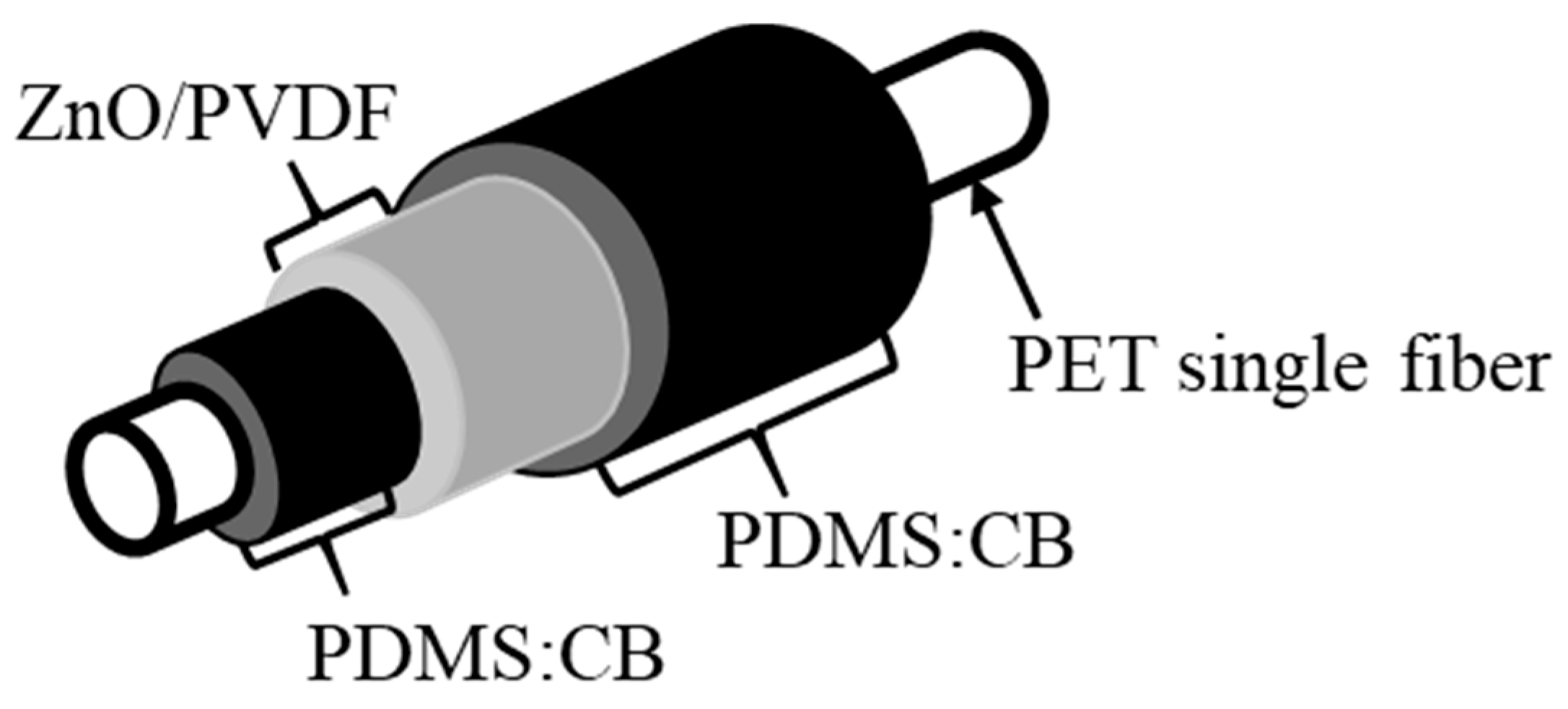
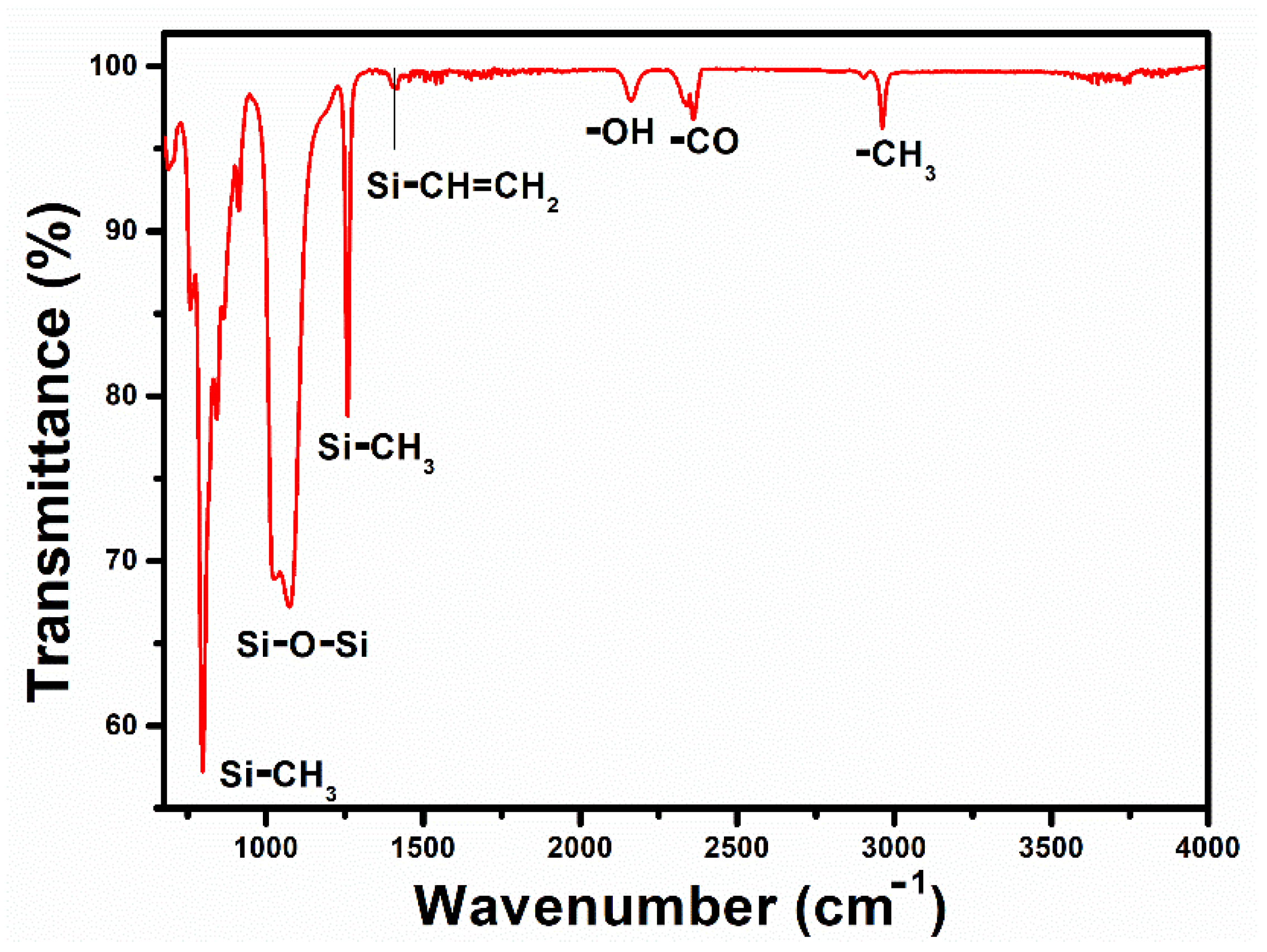

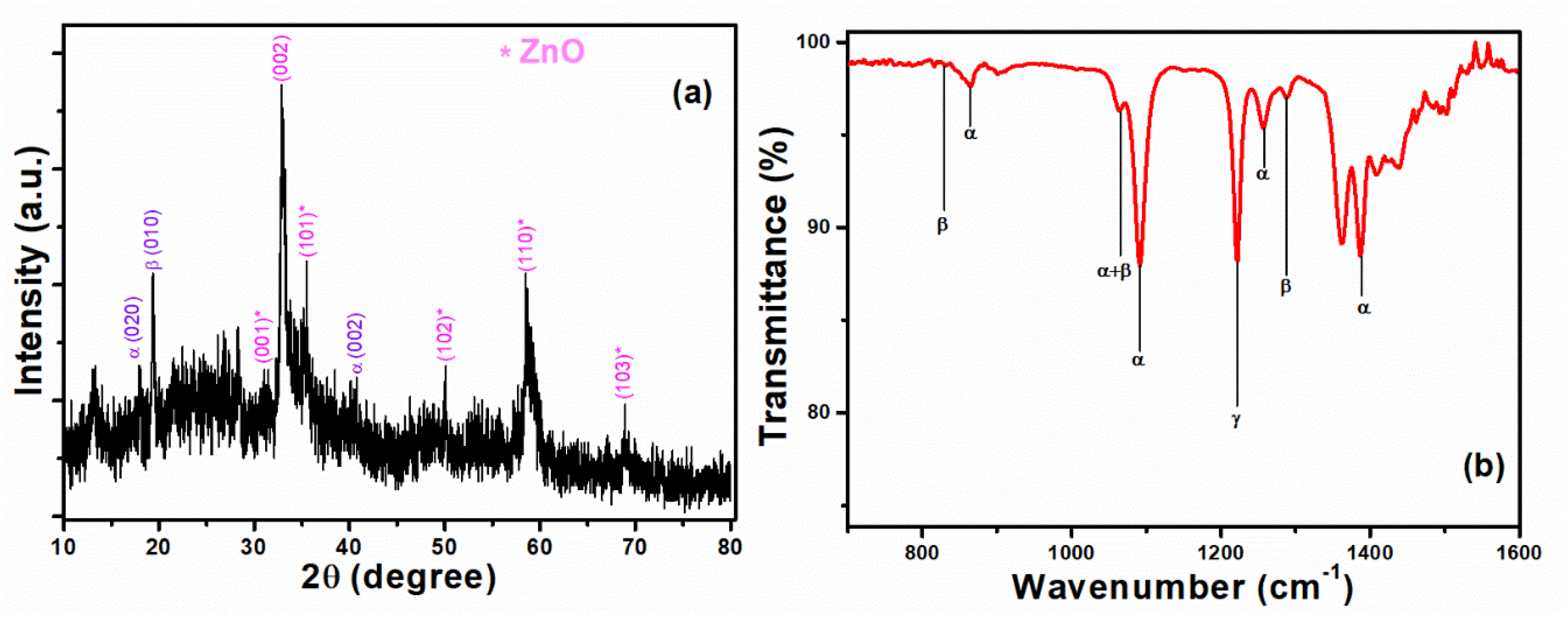
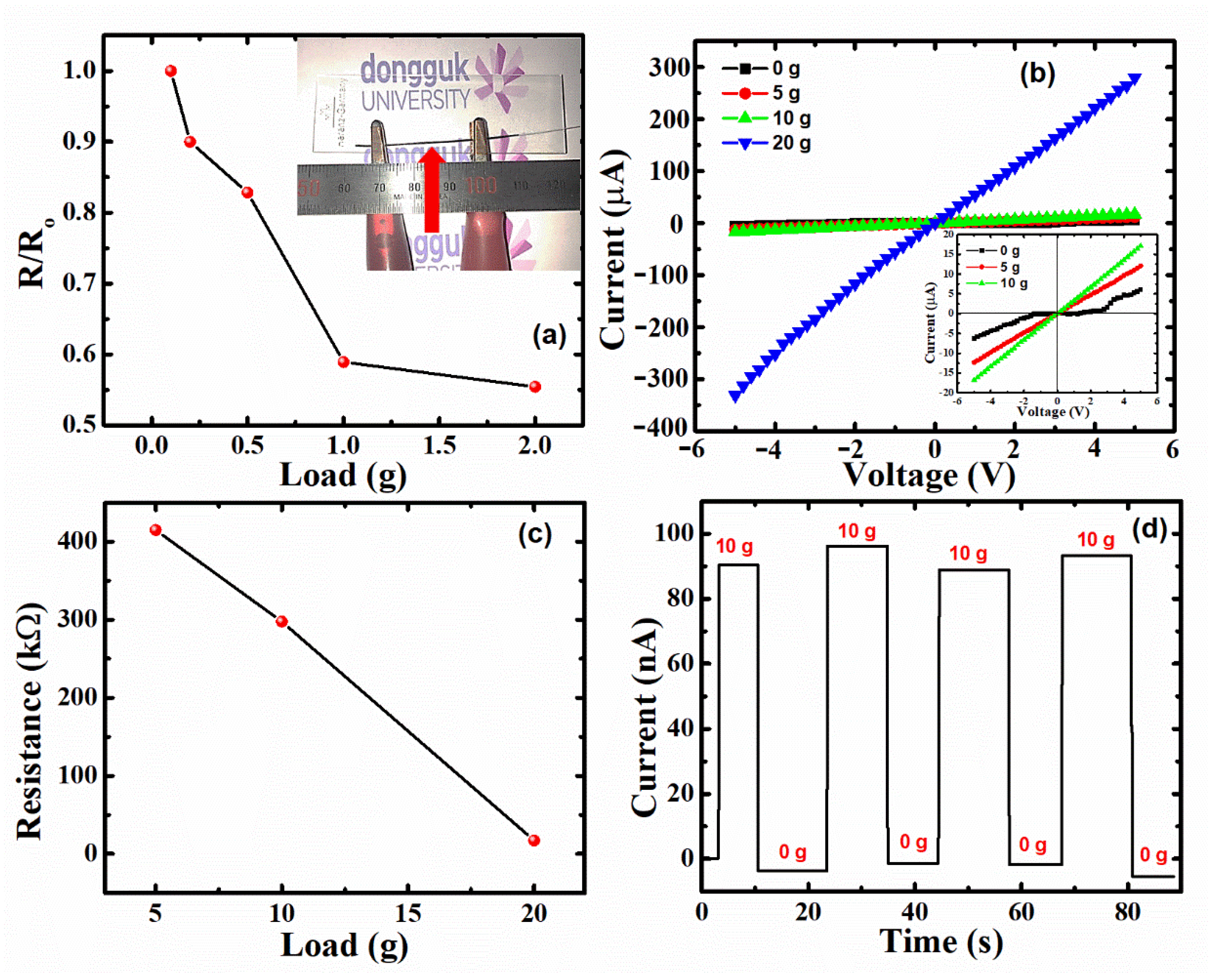
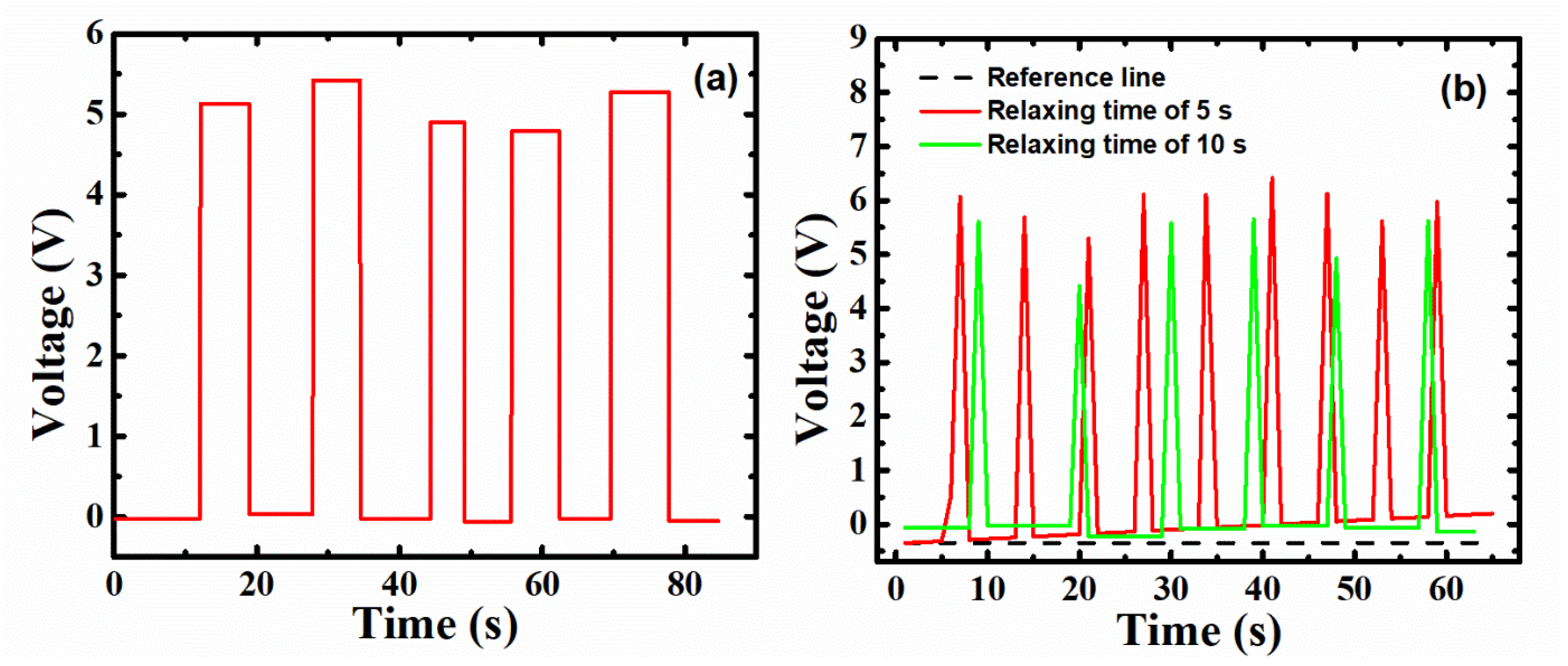
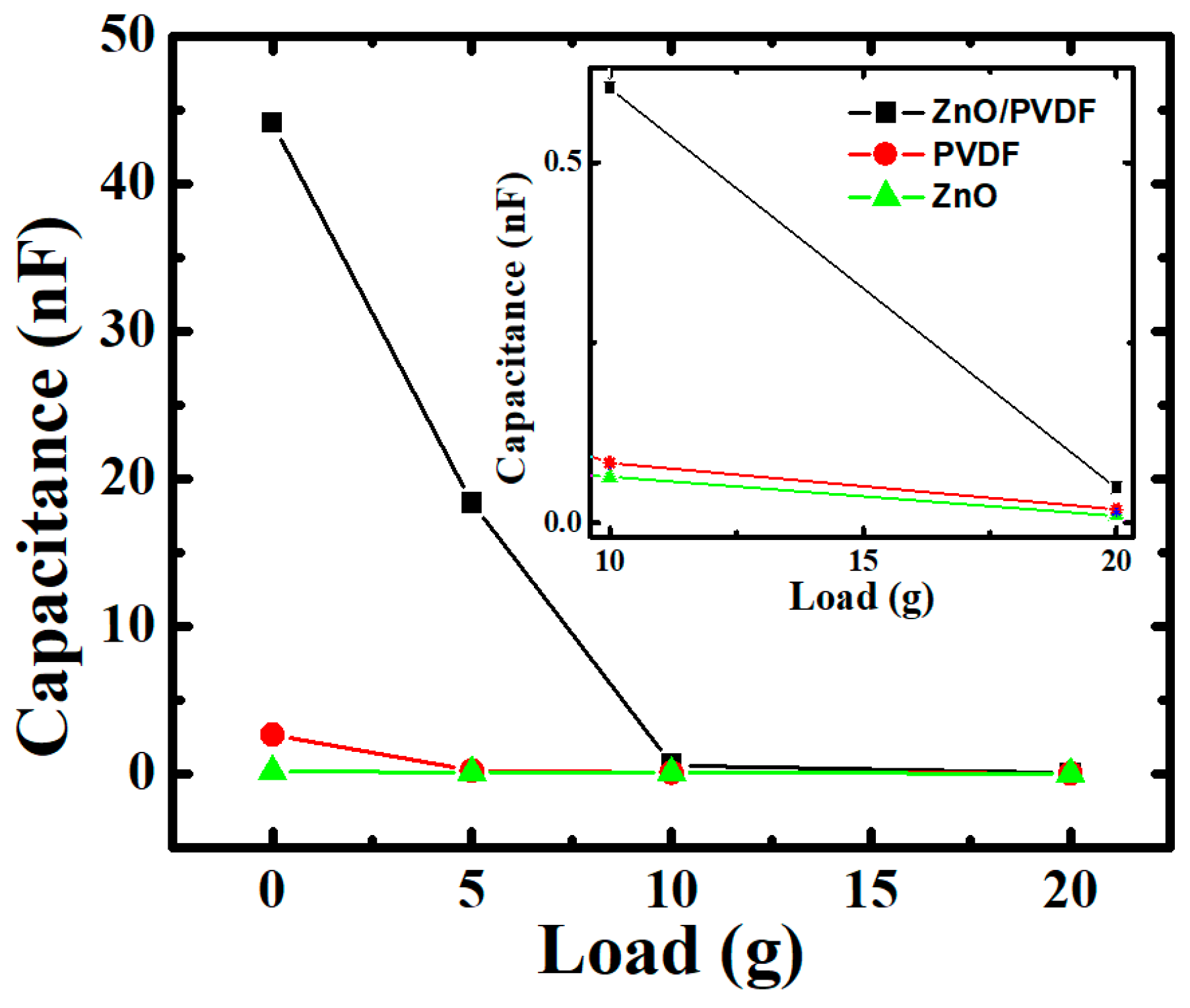
| Electrode Material | Substrate Structure | Maximum Output Voltage | Mechanism | Reference |
|---|---|---|---|---|
| Au/Cr | Fiber-type | 0.03 V | Piezoelectric | [28] |
| Ag | PVDF film | 2 V | Piezoelectric | [39] |
| Ag | PVDF film | 0.6 V | Piezoelectric | [38] |
| Ag | Cotton | 0.09 V | Piezoelectric | [61] |
| Au | PVDF | 1 V | Piezoelectric | [60] |
| Au | PVDF | 4.5 V | Triboelectric | [60] |
| ITO/PET | PDMS | 2.15 V | Triboelectric | [62] |
| ITO/PET | PDMS | 3.5 V | Triboelectric | [63] |
| ITO/Al | PET | 4.5 V | Triboelectric | [64] |
| PDMS:Carbon black | PET | 5.1 V | Combined triboelectric and piezoelectric | This work |
Publisher’s Note: MDPI stays neutral with regard to jurisdictional claims in published maps and institutional affiliations. |
© 2022 by the authors. Licensee MDPI, Basel, Switzerland. This article is an open access article distributed under the terms and conditions of the Creative Commons Attribution (CC BY) license (https://creativecommons.org/licenses/by/4.0/).
Share and Cite
Thakur, V.N.; Han, J.I. Combined Triboelectric and Piezoelectric Effect in ZnO/PVDF Hybrid-Based Fiber-Structured Nanogenerator with PDMS:Carbon Black Electrodes. Polymers 2022, 14, 4414. https://doi.org/10.3390/polym14204414
Thakur VN, Han JI. Combined Triboelectric and Piezoelectric Effect in ZnO/PVDF Hybrid-Based Fiber-Structured Nanogenerator with PDMS:Carbon Black Electrodes. Polymers. 2022; 14(20):4414. https://doi.org/10.3390/polym14204414
Chicago/Turabian StyleThakur, Vikas Narayan, and Jeong In Han. 2022. "Combined Triboelectric and Piezoelectric Effect in ZnO/PVDF Hybrid-Based Fiber-Structured Nanogenerator with PDMS:Carbon Black Electrodes" Polymers 14, no. 20: 4414. https://doi.org/10.3390/polym14204414





